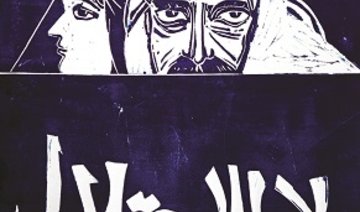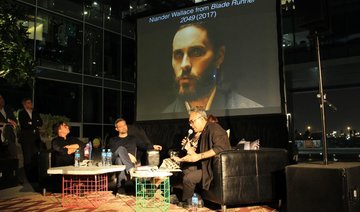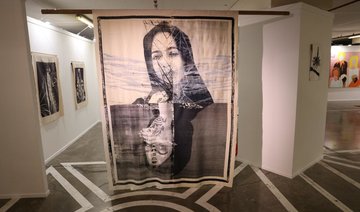If you are passionate about modern art from India and Pakistan, the Grosvenor Gallery’s stands at Art Dubai — which will run until March 24 — will leave you in a state of wonder if you are lucky enough to be visiting the city. Here you will find works by pioneering artists including Syed Sadequain, Ismail Gulgee, Anwar Jalal Shemza and Rasheed Araeen.
Talking to Arab News, gallery director Charles Moore pointed out that the art establishment mostly ignored artists from India and Pakistan who arrived in the UK in the 1960s. Their talent went largely unrecognized until certain key figures took it upon themselves to break through the wall of indifference.
One who led the way in overcoming prejudice is Rasheed Araeen, a conceptual artist, sculptor, painter, writer, and curator, primarily known for his minimalist open geometric wooden sculptures. He has been working as a visual artist since arriving in London from Pakistan in 1964.
“Araeen was very involved in the promotion of foreign artists in the UK; the establishment ignored artists from Africa, Central America and South Asia, many of whom contributed massively to the landscape of 20th century art but were largely ignored by public institutions,” Moore explained. “Araeen curated an exhibition at the Hayward Gallery in 1989 called ‘The Other Story’ which was a watershed moment — the first time any major UK institution showed such works. He also published journals such as the ‘Black Phoenix’ and ‘Third Text,’ which campaigned for these artists who were producing fantastic work in the UK but not getting recognition.”
Moore added that interest in Araeen’s work was “revitalized” after it was shown at Art Dubai and the Sharjah Biennale in 2014.
“That put him back in the international spotlight and since then there has been a huge amount of academic and institutional interest in him. His interactive work ‘Zero to Infinity’ was installed in last year’s Venice Biennale and there is a retrospective of his work currently on display at the Van Abbe Museum, Eindhoven, which will travel to MAMCO, Geneva, The BALTIC Center, Gateshead and Garage Museum, Moscow. His most recent works are very colorful, geometric paintings inspired by Islamic history and calligraphy and the mathematics of geometry and minimalism. When you look at the body of work which we are presenting in our catalogue at the fair, you can see the progression from the 1960s till now,” said Moore.
Pakistani artist Syed Sadequain is another who rose to prominence despite the establishment’s initial unwillingness to embrace Asian artists.
In the early 19060s, Sadequain won a competition to illustrate an edition of Albert Camus’ debut novel “L’Etranger.” “This was a big deal — it was worth quite a bit of money and enabled him to continue to live in Paris,” Moore said, noting that it was a great coup for Sadequain, an outsider competing against the great talent pool in Paris, to illustrate such an acclaimed novel, so beloved by the French.
Sadequain’s painting illustrates a scene from the very end of the novel.
“This expressive image comes from the final chapter of the book and shows the protagonist being crushed by his inner demons,” Moore explained. “Sadequain’s illustration of Camus’ existentialist masterpiece is one of the key moments of his career. So, to be able to exhibit the original work alongside others from this period is a great joy for us.”
Unlike his peers Sadequain and Araeen, Ismail Gulgee resisted the lure of the cultural capitals of Europe and remained in Pakistan. But he was no less innovative in his own way, Moore said.
“Gulgee (created) portraits of well-known figures but is also one of the pioneers of action painting in the region. His 1966 work ‘Abstract Forms’ is a wonderful large-scale piece and an early form of this type of painting. Usually his works from that period are much more figurative, executed in small brush-strokes, a technique akin to pointillism, but you can very clearly make out the subjects — whether they be horses, camels or polo players. This is a very early example of the style he became known for, which people really took to and which made him extremely popular.”
Dubai is just the latest stop on the painting’s absorbing journey around the world, as Moore explained.
“This painting was in the collection of the Bell Federal Credit Union in Nebraska. Heaven only knows how it got from Karachi to Nebraska in, presumably, the late 19060s. It came out of that collection in the 1990s and went to an owner who had it on their wall for 25 years, until we bought it.”
The London-based Grosvenor Gallery has been participating in Art Dubai since its first edition in 2007. For Moore, the event provides an excellent opportunity to connect with collectors.
“We have clients in the Gulf region who collect works by the artists we represent and there is a large Pakistani and Indian expat community who are actively engaged in learning about and seeing the works,” he told Arab News. “There aren’t many galleries in Dubai promoting this kind of material. It is difficult to see at the best of times. Even in London it is difficult to find, so the opportunities to see this material all in one go are few and far between.
“Dubai is a great venue. It works very well — the whole place goes crazy for art and a lot of work goes into these events. Also, Dubai is just an eight-hour flight from Europe, so it attracts people from these countries as well.”
On how the art market currently values works by established South Asian artists, he said: “On the whole I would say the market is in a relatively good place. The prices for modernist works have grown organically over a long period of time. You have the ‘Blue Chip’ names, and there are now well-established bench marks for certain artists. The difficult thing, as in any market, is sourcing good quality fresh material. As the years go on it gets harder and harder because for every wonderful picture you sell that’s one less in the market – but on the whole the market is in a fairly strong position without being too frothy or inflated.”
Prior to joining Grosvenor Gallery six years ago, Moore was a specialist in Middle Eastern and South Asian works of art at Bonhams auction house. He clearly relishes his work but warned casual observers not to be taken in by the calm atmosphere that often pervades galleries.
“Art galleries can be like swans in appearance – they appear to be very calm and sedate, but there is an intense amount of work going on behind the scenes,” he concluded.
Modern art from India, Pakistan breaks the mold at Art Dubai
Modern art from India, Pakistan breaks the mold at Art Dubai
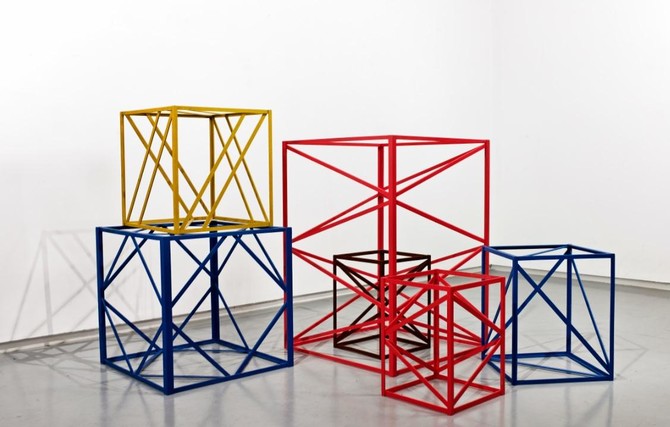
Moroccan photographer Hassan Hajjaj captures the culture of AlUla

- The acclaimed Moroccan photographer discusses his recent show in Saudi Arabia
DUBAI: Early in February this year, Moroccan contemporary artist and photographer Hassan Hajjaj was given a reminder of just how high his star has risen. Within a few days of each other, Hajjaj had shows opening in the US, Morocco, and — as part of AlUla Arts Festival — Saudi Arabia.
Hajjaj’s playful portraiture, which incorporates vivid color, funky clothing (almost all of which he designs himself), geometric patterns, and — often — vintage brands from the MENA region, has made him internationally popular, and his instantly recognizable style has established him as one of the world’s leading photographers.
His show in AlUla consisted of images that he shot in the ancient oasis town in February 2023. That visit was initially supposed to involve shoots with around 20 local people. It’s the kind of thing he’s done a few times before, including in Oman and Abu Dhabi. “It’s always a good opportunity to get to know the culture and the people,” Hajjaj tells Arab News.
But, as he says himself, he arrived in AlUla as “an outsider,” so needed a team on the ground to persuade locals to come and sit (or stand, in most cases) for him.
“It was a bit tough, in the beginning, for them to find people,” Hajjaj explains. “But because it was during a period when lots of art things were happening in AlUla, there were lots of people coming from outside AlUla as well. So we opened it up. I basically said, ‘Just come.’
“In the end lots of people turned up, not just locals — people from Riyadh, Jeddah, and people (from overseas) too. I think I shot around 100 people over a few days. So it was a great opportunity,” he continues. “To get to shoot that many people over three days — organizing something like that for myself might take a year. So, as long as I have the energy, when I get these opportunities — you know, I’m in AlUla with this eclectic bunch of people — I’d rather go and grind it, really work hard, and have that moment.”
A Hassan Hajjaj shoot isn’t your regular portrait shoot, of course. “It’s almost like a performance,” he says. “There’s music, people dress up, it’s like a day out for them, taking them out of themselves for a few hours.”
He followed the same modus operandi in AlUla. “We got an ambience going. It was fun, there was music… I shot in this beautiful old school that was one of the first girls’ schools in Saudi Arabia, from the Sixties. Upstairs was like a museum — everything was like a standstill from the Seventies and Eighties; even the blackboards had the chalk and the writing from that time,” he says.

A crucial part of Hajjaj’s practice is to ensure that his subjects are at ease and feel some connection with him (“comfortable” is a word he uses several times when talking about his shoots). While all his portraits bear his clearly defined style, it’s important to him that they should also show something unique to the people in them.
“It’s that old thing about capturing the spirit of the person in that split second, you know? I’m trying to get their personality and body language in the image,” he says. “Quite often I’m shooting in the street, outdoors, so (the subjects) can start looking at other people, thinking, ‘Are they looking at me?’ So I usually say, ‘Listen. This is a stage I’m building for you. I’m dressing you up, and we’re going to have fun.’ Then I just try and find that personality that can come out and make the image stronger. With some people, though, saying almost nothing can be better — just getting on with it. I try to kind of go invisible so it’s the camera, not the person, that’s doing the work. The best pictures come out when there’s some kind of comfortable moment between me and the person and the camera.”
It’s the way he’s worked since the beginning — a process that developed organically, as most of his early portraits were of “friends or friends of friends.”

“There’s a comfort in that because you have a relationship with them. It made it easy,” he says. “And that taught me about how important it is to build trust with people to get into that comfortable zone. But as time went on, obviously, people could see the stuff in the press or on social media, so then people started, like, asking to be shot in that manner; maybe they’ve studied the poses of certain people and stuff like that, so they come ready to do some pose they’ve seen in my pictures. That’s quite funny.”
The work that was on display over the past two months in Hajjaj’s “AlUla 1445” is a perfect example of what he tries to achieve with his shoots. The images are vibrant, playful, and soulful, and the subjects run from a local goatherder through the AlUla football team to bona fide superstars: the US singer-songwriter Alicia Keys and her husband Swizz Beatz.
Hajjaj says he has a number of favorites “for different reasons,” including the goatherder.

“He brought in two goats and it became quite abstract when you put all of them together. I was playing with that notion of the person; you could see that’s his life and even the goats look happy,” he explains. “I wanted to make sure they had that shine in the image as well. I got some great shots of him.”
The Alicia Keys and Swizz Beatz shoot has been a long time in the making. Hajjaj first met Swizz Beatz a decade ago, and they have been in touch intermittently ever since. The idea of a shoot with Keys first came up about five years ago, but logistics had always got in the way. But since they were playing a concert in AlUla at the same time as Hajjaj was there, it finally happened, on Hajjaj’s last day, with perhaps an hour left before the light faded.
I ask Hajjaj if his approach to shooting celebrities differs from his shots of “ordinary” people.

“There’s probably not that much difference,” he says. “They’re coming into my world, so, again, it’s just making sure they’re comfortable with you and you’re comfortable with them; not looking at them (as celebrities). The only thing is you have to imagine they’ve been shot thousands of times — by top photographers, too — so they’re going to have their ways. So I just have to lock in with them and find that comfortable space between the sitter and me.”
And then there’s Ghadi Al-Sharif.
“It’s a beautiful picture. She’s got this smile, with her hand over her face. For me, that one really presents the light and the energy of AlUla,” Hajjaj says. “It captures the new generation.”
Ithra showcases Arab creatives at Milan Design Week

- The Dhahran-based cultural center took part in the prestigious Italian fair last month
DUBAI: The King Abdulaziz Center for World Culture (Ithra) participated in Milan Design Week between Apr. 16 and 21. It was the second time Ithra has taken part in the annual event — a significant entry in Italy’s cultural calendar.
Ithra was founded with the goal of developing Saudi creative talent. Noura Alzamil, the center’s head of programs, has seen its influence mushroom since the beginning and continues to be in awe of her country’s rapidly developing art scene.
“Practicing it and seeing it every day around you and reading about it in articles and seeing that interaction and conversation on a national level, is really heartwarming,” she says.

“We’ve been active for the past 13 years, in collaboration with the Ministry of Culture, doing a lot of enriching programs, activations, bringing in new content and experimenting with our community and exposing them to arts, museums theatre, films,” Alzamil adds. “To me, investing in Saudi minds helps them excel in the future. I believe heavily in taking care of young talents, supporting professionals and having a global conversation.”
Ithra also houses what it bills as the region’s first ‘Material Library,’ displaying a variety of raw design materials. “Artists are all about experimentation,” Alzamil says. “The Material Library hosts hundreds of different materials that designers can come and play with.”
A cornerstone of Ithra’s programming is Tanween, a four-day conference that showcases creative designs from university students and emerging creatives from the region. The products from the conference are then exhibited in public events, such as Milan Design Week.

“To me, and to Ithra, it’s really important to showcase our efforts and Saudi and Arab designers in such festivals. Being presented among our peers there is something that we really care about,” says Alzamil. This year, Ithra presented an exhibition of items created by MENA artists in a wide range of mediums in Milan — the first time the center has presented a full show there.
Entitled “From Routes to Roots” and presented in collaboration with Isola (a Milan-based digital platform), the show included glasswork, clay, rugs and lighting. One of the key ideas of the exhibition was to demonstrate how creatives are preserving heritage and the Earth through circular design, which helps to eliminate waste from production.
“They used a lot of integrating bio materials, natural resources, household and industrial waste to come up with these innovative designs and objects that showcase and support sustainability,” Alzamil says.

Participating creatives hailing from the Levant, North Africa and the Gulf included Marwa Samy Studio, Ornamental by Lameice, Joe Bou Abboud, T Sakhi Studio, Bachir Mohamad, Studio Bazazo, and Mina Abouzahra.
“The exhibition draws inspiration and expertise from ancestral culture pairing it with cutting-edge craftsmanship, in a demonstration of how emerging talents can breathe fresh life into the design landscape, bridging the gap between tradition and innovation,” according to a press release.
Lebanese designer Bou Abboud presented a triad of round lighting fixtures that he says pay tribute to old Qatari jewelry, particularly long necklaces.
One of the more delicate pieces on view came courtesy of Jerusalem-based Palestinian designer Lameice Abu Aker. Her light-toned vases, jugs and drinking glasses are fluid and bubbly. She showcased a molecular-looking, violet vase called “Chemistry!” On Instagram, Abu Aker’s brand posted that the piece is “the perfect fusion of art and science, crafted with precision and care by our skilled artisans. Mouth-blown, every curve and line reflects the magic of the chemical reactions that inspired its name.”
Hanging textiles were also noticeably dominant in Ithra’s display. For instance, Doha-based artists Bachir Mohamad and Ahmad Al-Emadi collaborated on geometrical, symbol-heavy, blue-and-white rugs that are an homage to traditional Gulf Sadu weaving, historically practiced by Bedouins.
“It was really exciting,” Alzamil says of the show. “The team received a lot of visitors and different players in the field. . . It’s bridging the gaps between Saudi and international communities.”
London’s Arab Film Club launches podcast focusing on Palestine

DUBAI: The Arab Film Club, a monthly gathering in London celebrating Arab cinema, launched a podcast on May 1.
Spearheaded by the club’s founder, Sarah Agha, an Irish Palestinian actress and writer, the inaugural five-episode season of the interview-based podcast will focus on Palestinian filmmakers and cinema’s role in cultural resistance.
The debut episode features Darin J. Sallam, director of “Farha,” Jordan’s Oscars entry in 2022. In other episodes, Agha interviews Lina Soualem, (“Bye Bye Tiberias”), Ameen Nayfeh (“200 Metres”) Annemarie Jacir (“Wajib”) and Farah Nabulsi (“The Teacher”).

Agha told Arab News, “It is so urgent right now to do anything and everything we can to keep talking about Palestine. So I thought, ‘Why not do some interviews with some of my favorite Palestinian directors and put them online so everyone can listen to them?”
Reflecting on Sallam’s episode, Agha highlighted the transformative potential of cinema. “She is linking educational talks with her film, and I do believe her film is like a tool of change,” the presenter said.
Agha said she found Soualem’s documentary particularly intriguing, due to its departure from the scripted films typically showcased at the Arab Film Club.

“I wanted to make an exception for Soualem’s film because it’s another portrayal of the Nakba, but in very different terrains — like, totally different,” she explained. “My father is from Tiberias, so I was also attracted to it for that reason.”
Agha believes her podcast is launching at a time when Palestinians are being censored in the arts.

“There’s been a lot of cancellations of events to do with Palestine and Palestinian narratives,” she said. “So I think the best thing that we can do is not succumb to hopelessness. The fact that they’re trying to silence voices means those voices are significant. You don’t silence something that’s irrelevant. For example, the fact that the Israeli government tried to pressure Netflix into removing Darin’s film shows that it’s important.”
Agha hopes the podcast will appeal to a diverse audience, including non-Arabs.
“That, for me, is a really big thing. If we just talk to ourselves all the time, we won’t really get any further with reaching a wider audience,” she said.
The Weeknd donates $2 million for humanitarian aid in Gaza
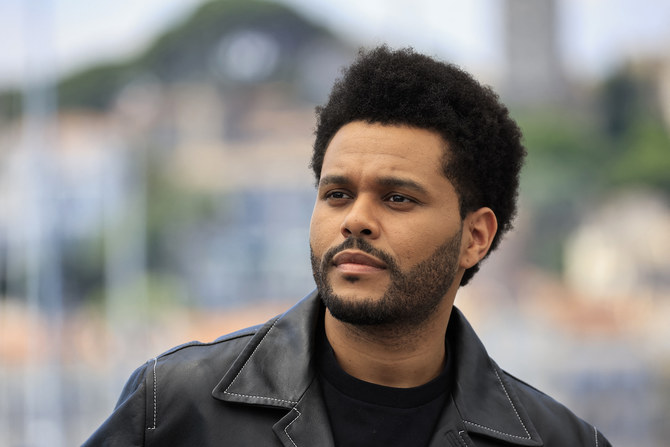
DUBAI: Canadian singer The Weeknd has pledged to donate another $2 million to help feed families in Gaza, the United Nations’s World Food Programme reported.
The donation comes from the star’s XO Humanitarian Fund, which helps combat global hunger.
“This support will provide over 1,500 metric tons of fortified wheat flour, which can make over 18 million loaves of bread that can help feed more than 157,000 Palestinians for one month,” said WFP.
In December, the multi-platinum global recording artist, whose given name is Abel Tesfaye, donated $2.5 million to WFP from the fund, which he established in partnership with World Food Program USA. That equated to 4 million emergency meals, funding 820 tons of food parcels that could feed more than 173,000 Palestinians for two weeks.
Tesfaye, who was appointed a Goodwill Ambassador in October 2021, is an active supporter of WFP’s global hunger-relief mission. He, his partners and his fans have raised $6.5 million to date for the XO fund.
In total he has directed $4.5 million toward operations in Gaza and has sent $2 million to support WFP’s emergency food assistance for women and children in Ethiopia.
DJ Peggy Gou makes waves in the Middle East, eyes collaborations with Arab artists

ABU DHABI: South Korean DJ and singer Peggy Gou is no stranger to the Middle East. She wowed fans this week at the Louvre Abu Dhabi in the UAE, performing in celebration of the newly opened exhibition “From Kalila wa Dimna to La Fontaine: Travelling through Fables,” and revealed that she would consider collaborating with Arab artists.

She told Arab News the morning after the event: “I woke up this morning and was thinking what happened last night. It is one of those events that is so meaningful. I’ve been to Abu Dhabi twice just to see the exhibitions. It’s more than a museum to me. It is a community, where people even go to hang out. That’s how beautiful that place is.”
Gou was among the first performers to take the stage at the Louvre Abu Dhabi in front of an audience, she said.
“I know David Guetta did it once before without an audience during COVID-19 … It was my first time playing in Abu Dhabi. It was insane. It was a very, very special night, and I want to do more,” she added.

Gou incorporates Arab-inspired music into her performances, noting that “people just love it, and they love percussion.”
To the artist, music is like a feeling. “It is really hard to rationalize it,” she said. “When you love it, you just love it,” she added, expressing her admiration for Arab melodies.
“This is maybe the reason why people support my music, even though they don’t understand the language. Sometimes they just feel it, they just love it,” she explained.
“I love our music, but at the same time, I’m considering collaborating with an Arab artist because there are a lot of talented Arab musicians here,” she said. “I have many friends here who recommended me some artists, and I want to check it out.
“I never say no. I love making music with different languages.”
Gou has performed in Saudi Arabia multiple times.
“Every time I go there, it’s different. But what I can say is it’s always changing in a good way. In the very beginning, I felt like they weren’t going to understand my music,” she recalled.
But the DJ said that her last performance in AlUla was one of her favorites. “People were just shouting, screaming, and dancing as if there was no tomorrow,” she said.





